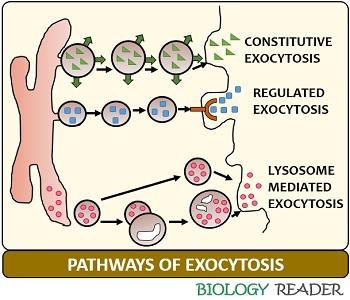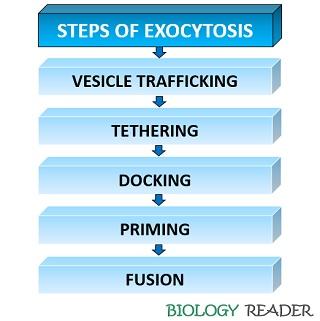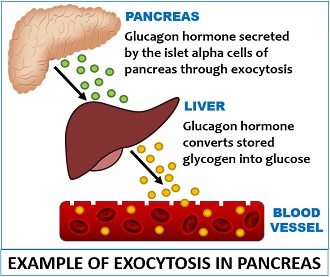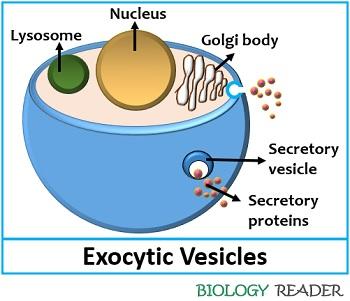Exocytosis is a means of membrane transportation that expels the intracellular material out of the cell. The transport of the substance is mediated by the vesicles that eliminate the cell debris and release specific proteins, enzymes, hormones etc., outside the cell.
It is a type of active transport mechanism that makes the use of ATP. Examples of exocytosis include the release of enzymes into the blood, neurotransmitters into the synapse, and plasma membrane proteins out of the cell.
In this post, we will discuss the definition, constitutive, regulatory and lysosome mediated pathways. Besides that, the characteristics, steps, example and the process of vesicle formation have been explained.
Content: Exocytosis
Definition of Exocytosis
Exocytosis refers to the cellular mechanism, where the transport vesicles incorporate with the cell membrane and eliminate the materials out of the cell via constitutive, regulatory and lysosome mediated secretory pathways. Thus, exocytosis merely refers to the process, which expels the biomolecules and metabolic waste from the cell to the extracellular space.
Pathways of Exocytosis
Generally, exocytosis is mediated by the given three pathways:

Constitutive Secretory Pathway
This kind of mechanism can be carried out by all cells. It is operated continuously to deliver the newly generated lipids, proteins etc., from the Golgi complex to the bilayer cell membrane.
Regulated Secretory Pathway
The specialized cells carry out this pathway by secreting specific hormones, proteins, enzymes, neurotransmitters etc., from the cytosol to the extracellular space.
The regulated secretory pathway requires extracellular signals for the exudation of substances out of the cell. It only occurs in the secretory cells, not in all the cell types. Only the specific substances will expel out of the cell when they are stimulated by the extracellular signals.
In this kind of pathway, the secretory vesicles do not incorporate completely with the cell membrane and only fuse enough to expel the contents out of the cell. This kind of secretory vesicles reform and go back to the cytosol once they deliver the material out of the cell.
Lysosome Mediated Secretory Pathway
This pathway involves the incorporation of the lysosomes with the bilayer cell membrane. Lysosome mediated secretory pathway functions to exclude the undigested cellular debris out of the cell.
A lysosome appears as a small vesicle, which contains an acid hydrolase enzyme. The hydrolytic enzymes function to break down the waste materials and microbes. They carry the cellular debris to the bilayer cell membrane and fuse to expel the contents out to the extracellular matrix.
Characteristics
- The transportation in exocytosis occurs from the interior of the cell, i.e. cytosol, to the exterior or extracellular space of the cell.
- Mechanism of exocytosis plays a significant role in the exudation of the metabolic waste out of the cell, chemical messaging between the cells etc.
- Exocytosis forms the exocytic-vesicles.
- The Golgi body and presynaptic neurons are the cell regions, which processes the formation of exocytic-vesicles.
- Exocytic vesicles require precursors of the endoplasmic reticulum, which are later processed by the Golgi body. Finally, the secretory vesicle buds off through the trans face of the Golgi body.
- There are three pathways, namely constitutive, regulated and lysosome mediated secretory pathways, that are the three primary mechanisms of exocytosis.
Steps of Exocytosis
Generally, exocytosis involves five steps for the expulsion of intracellular substances.

- Vesicle trafficking: In this step, the transportation of vesicles to the cell membrane occurs along with the microtubules of the cytoskeleton. Motor proteins, kinesins, dyneins and myosins mediate the movement of secretory vesicles.
- Tethering: Once the vesicles reach the cell membrane, they tend to contact the cell membrane.
- Docking: The third step involves the attachment between the cell membrane and the vesicle membrane. During this step, the phospholipid bilayer of both membranes begins to merge.
- Priming: It is the step that only occurs in the regulated exocytosis. Priming involves specific modifications in the molecules of the cell membrane for the signalling process to stimulate exocytosis.
- Fusion: Two types of fusion occur in exocytosis.
- Complete fusion: Here, the vesicle membrane entirely merges with the cell membrane. It makes the use of ATP that helps in the separation and fusion of the phospholipid membrane. The fusion results in a fusion pore that expels the content out of the cell membrane.
- Kiss and run fusion: It’s the temporary fusion of the vesicles with the cell membrane, which facilitates the expulsion of the contents out of the fusion pore. After the release of substances to the extracellular environment, the vesicles detach from the bilayer cell membrane.
Example
Exocytosis in Pancreas: When the blood sugar level becomes low, the islet alpha cells of the pancreas release glucagon hormone via exocytosis. Then, the glucagon hormone activates the hepatic cells of the liver, which facilitate the transformation of stored glycogen into glucose. Then, the glucose released by the liver cells finally goes into the bloodstream until it reaches a normal range.

Formation of Secretory Vesicle
Golgi complex or the protein packaging organelle forms the secretory vesicles. The Golgi bodies release secretory vesicles from their trans face. The release of a secretory vesicle can be calcium-dependent or independent.

The calcium-dependent cycle serves as a regulated secretory pathway, which requires specialized cells to release the vesicular contents. In contrast to this, the cells carrying out a constitutive pathway are calcium-independent.
Once the vesicles release from the Golgi complex, they tend to move near to the cell membrane. Finally, there will be a fusion between the vesicle membrane and the cell membrane, and the contents will go out into the extracellular space.